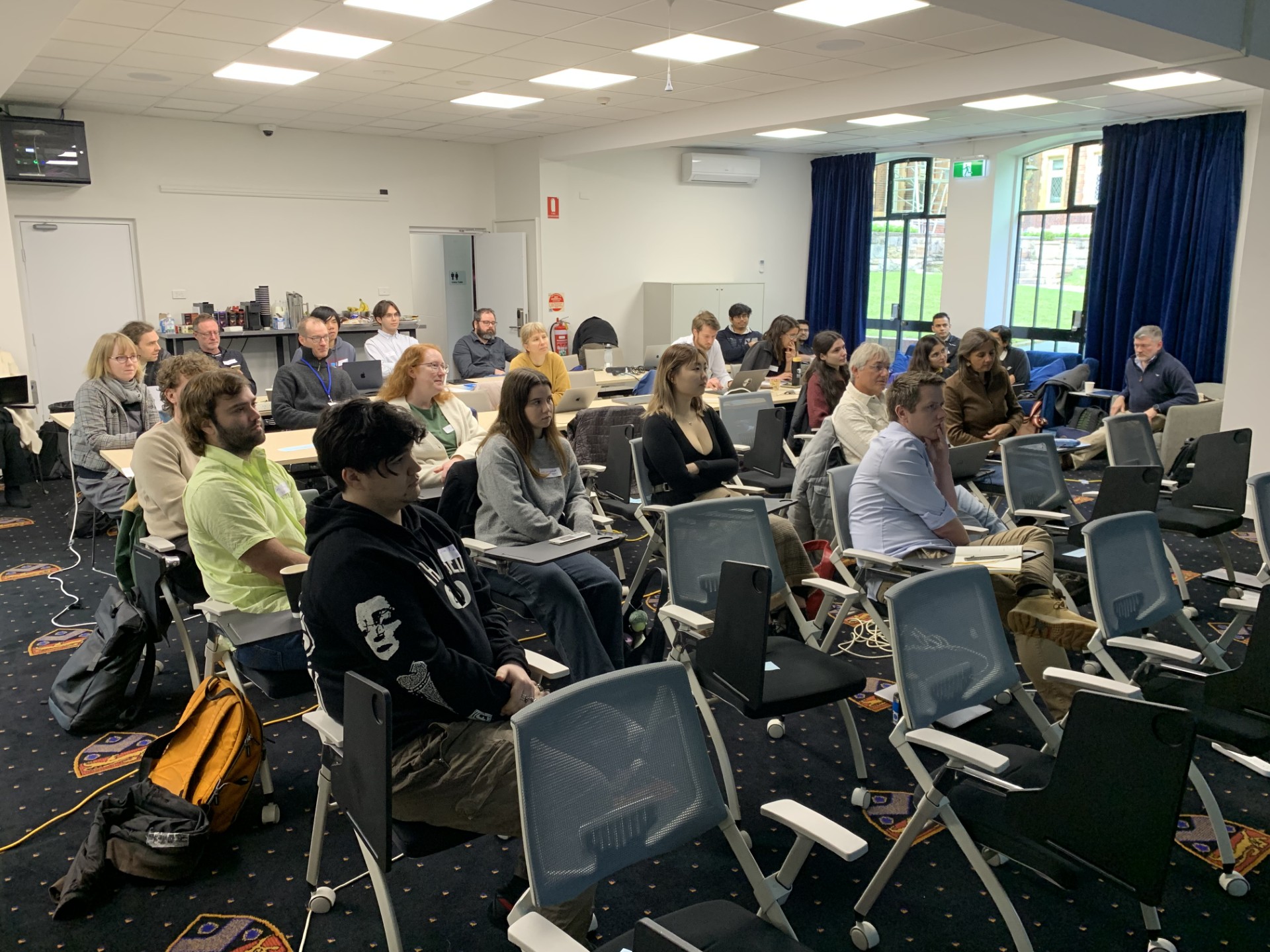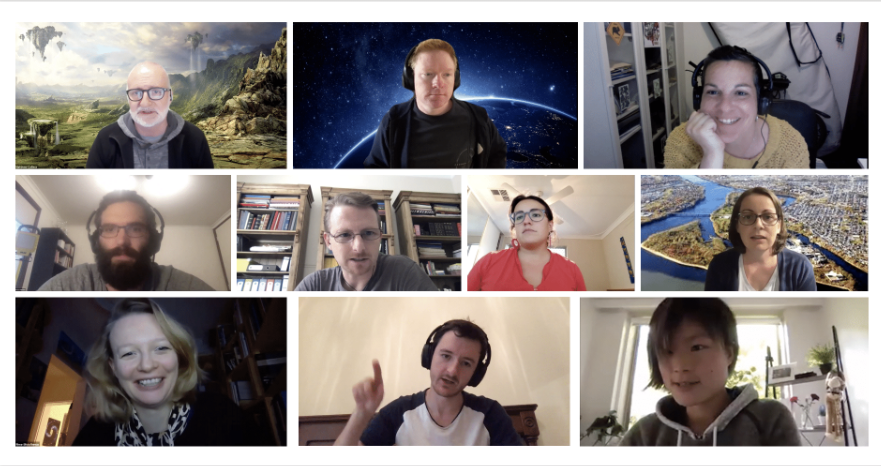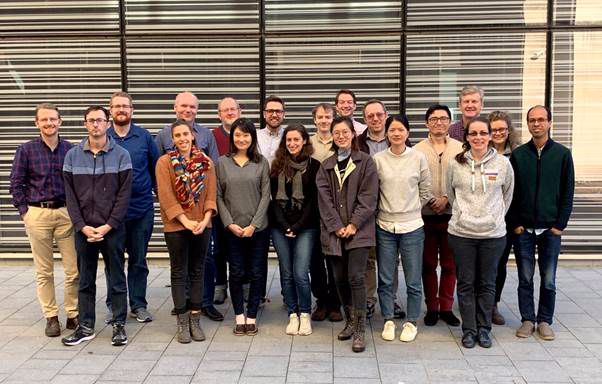Hunstead Workshop
2025 Hunstead Workshop: New Science Enabled by GAIA DR4 - The Star-Gas Connection
New Science Enabled by GAIA DR4 – The Star-Gas Connection
For the past decade, ESA Gaia has been a revelation for Galactic studies, supported by major ground-based spectroscopic surveys (GALAH, APOGEE, LAMOST) and space-based astrometric surveys (Kepler, K2, TESS). In mid 2025, Gaia ceased observations but the bulk of the data have yet to be analysed and released as DR4 in late 2026.
Our 2025 Distinguished Hunstead Visitors (Alejandra Recio-Blanco & Patrick de Laverny, Nice Observatory) play a key role in Gaia releases, and joined us in August to discuss new science directions.
The unique features of the workshop was to focus on Galactic ecology (i.e. the interplay of gas and stars over billions of years). In gas-poor galaxies, stars tell gas how to move; in gas-rich galaxies, the reverse is true. Since all discs went through a gas-rich phase, what are the remnants of that early epoch? Do gas clouds scatter stars? Are stars ever born “hot”? Do spiral arms emerge because of gas or stars, or both? What is the origin of azimuthal abundance variations seen by Gaia? What is the role of bar formation and its subsequent evolution? What stellar processes (e.g. resonances, migration, bars, spiral arms) are altered by the presence of the gas-rich phase? These discussions were be aided by remarkable progress in simulating Milky Way “surrogate” galaxies in a controlled and/or cosmological context. There are also lessons to be learned from local galaxy surveys that target Milky Way “analogues.” This meeting focused predominantly on the science of postdocs and PhD students.
Workshop recordings (Note: Monday did not have any audio due to technical glitch)

|
DAY 1 – 18 August (M) |
DAY 2 – 19 August (T) |
||
|
Stellar surveys (9.00-10.40am) |
Star/gas interaction, Galactic ecology (1.50-3.30pm) |
Chemistry, very high resolution spectroscopy (9.00-10.40am) |
External galaxies and MW connection (1.50-3.30pm) |
| 1: Recio-Blanco – Gaia DR4 | 9: Tepper-Garcia – NEXUS & new era of galaxy models | 1: Karakas – chemical evolution overview | 9: Tsukui – JWST/ALMA double disc evolution |
| 2: de Laverny – Gaia DR4 | 10: Davis – NEXUS & CO/HI surveys | 2: Aquilina – HARPS hi-res abundances | 10: Wisnioski – JWST/ALMA early discs |
| 3: Buder – GALAH DR4 | 11: Joshi – bar buckling | 3: Ness – GALAHAD survey | 11: van de Sande – GECKOS |
| 4: Zucker – Gaia DR3 RVS | 12: Iles – internally vs externally excited bars | 4: Casey – new developments in abundance pipelines | 12: Croom – SAMI+Hector |
|
Coffee (10.40-11.10am) |
Coffee (3.30-4.00pm) |
Coffee (10.40-11.10am) |
Coffee (3.30-4.00pm) |
| 5: Lewis – S5 streams survey | 13: Yamsiri – Gaia phase spiral, latest developments (Z) | 5: Stello – M67 stellar ages and masses | 13: Theron – molecules in early discs & turbulent sims |
| 6: Bolwell – K-bonus survey | 14: Barbillon – spiral arms in NEXUS & New Horizons (Z) | 6: Cornejo – dwarf galaxy spectroscopy with MUSE | 14: Agertz – First discs to Milky Way in VINTERGATAN sims (Z) |
| 7: Sharma – NASA Roman disc plane survey (Z) | 15: Palicio – disc actions in Gaia DR3 and NEXUS (Z) | 7: Kos – GALAH clusters | 15: Nyhagen – New insights VINTERGATAN sims (Z) |
| 8: discussion – Martell | 16: discussion – Buder | 8: discussion – Ness | 16: Freeman – thoughts |
|
Lunch (12.50-1.50pm ) |
End (5.40pm) |
Lunch (12.50-1.50pm) |
End (5.40pm) |
2025 Hunstead Workshop: OzGrav Dynamic Radio Sky
2024 Hunstead Workshop: MESA Down Under Winter School
MESA Down Under Winter School
brought together 23 teachers and 39 participants form around the world to develop skills in the use of Mesa, an open-source Python library for agent-based modelling, ideal for simulating complex systems and exploring emergent behaviours.
The stellar structure and evolution code Modules for Experiments in Stellar Astrophysics (MESA) has played a pivotal role in making the study of stellar structure and evolution readily accessible to the broad astronomy community. It was identified as a key software tool for astronomy in the 2020 U.S. Decadal Survey and has “seeped into the foundation of research and education efforts and have given rise to an immense amount of new research across multiple subfields of astrophysics,” as quoted in the 2021 Beatrice M. Tinsley Prize awarded to the first MESA developer, Bill Paxton, by the American Astronomical Society. Since 2012, annual MESA schools have been organised to teach new users and the next generation of astrophysicists and MESA developers how to use the code. In June 2024, the MESA school was brought to Australia for the first time under the name MESA Down Under, with the intent of making the school more accessible to students and early career researchers in Australia who constituted 40% of the 39 participants of the school. The 21 invited international lecturers and teaching assistants participating in the school provided both lectures and hands-on exercises on the basics of the code and a variety of example science applications. The high teaching assistant to student ratio (1:3) provided an optimal learning environment for the students, ensuring that they could easily get help and ask questions if they encountered any issues.
 MESA Down Under Participants
MESA Down Under Participants
 MESA Workshop Session
MESA Workshop Session
 Invited Speaker – Prof. Jan Eldridge
Invited Speaker – Prof. Jan Eldridge
2023 Australian Exoplanet Workshop (9AEW)
9th Australian Exoplanet Workshop (9AEW)
This was the first workshop since 2018 taking place after the worst of the Covid pandemic with 65 in-person participants, plus 10 joining online. The program featured talks, a poster session, collaborative sessions, and a panel discussion about the future of the field.
The highlights were:
- Invited speaker Marshall Perrin’s talk “Imaging Planetary Systems with JWST”
- Sergio Leon-Saval’s talk (and demo!) about the applications of photonic lanterns for the field.
- Michele Bannister’s planetary science talk delivered from New Zealand.
Other talks featured stellar activity and rotation, asteroseismology, stellar interior models, star-planet tidal evolution, stellar and planet mapping, polarimetry of circumstellar environments, atmospheric chemistry of Hot Jupiters, evaporating atmospheres, disk kinematics, exokuiper belts, transits photometry to learn about both the planet and the star, astrometry, software, astrophotonics, and new missions and facilities— like the TOLIMAN satellite currently under development to perform interferometric astrometry on the nearest star system to hunt for planets.
 Above: Sergio Leon-Saval presenting on the power and promise of photonic lanterns
Above: Sergio Leon-Saval presenting on the power and promise of photonic lanterns

Left: The in-person participants represented Australian institutions University of Sydney, Macquarie University, the University of New South Wales, Australian National University, Monash University, the University of Newcastle, the University of Queensland, the University of Southern Queensland, Western Sydney University, and Sydney Observatory.
2020 Hunstead Workshop: MAGPI Virtual Workshop
MAGPI Virtual Workshop
Virtual workshop, 14-17 April 2020.
MAGPI team members and representatives from relevant surveys and theoretical simulations also joined our productive 4-day meeting. Twenty-three people attended (virtually) from Australia and Europe to discuss the survey status, science updates and took part in strategic workshops, including various synergies with other groups.
Intensive 2-hour sessions were held each day. These were recorded and posted on the internal wiki for those who were unable to join live. Participants were encouraged to turn on their camera when they were speaking to allow for a more personal experience. As this was a “hands-on” workshop, participants came up with innovative ways to collaborate remotely. Tools like Slack, GitHub, Zoom, cloud storage and virtual desktops were amongst the tools that made the meeting a success. Feedback from all involved was overwhelmingly positive.
As the event was originally planned face-to-face, we would like to thank the Hunstead Gift for Astrophysics for their generous support, although we did not incur any costs.

2019 Hunstead Workshop: Dynamical Models of Observed Galaxies
Dynamical Models of Observed Galaxies
The University of Sydney, 3-7 June 2019
Large new IFS Galaxy Surveys allow for a more detailed insight in the dynamical properties of galaxies than ever before. IFS instruments such as VLT-MUSE, AAT-SAMI, and MaNGA are now intensively used by the Australian community to understand how galaxies build up their mass and angular momentum over time. At the same time, there has been a revolution in surveying the Milky Way with ESA-Gaia, GALAH and APOGEE, resulting in an extraordinary number of recent publications on the dynamical properties of our own Galaxy.
Dynamical models of galaxies are crucial for interpreting all these stellar kinematic measurements, but fitting these models still requires a significant amount of effort and expertise. This workshop is aimed at making dynamical fitting and modelling more accessible to the Galactic and extragalactic community.

2018 Hunstead Workshop: Planets in Peculiar Places
Planets in Peculiar Places
The University of Sydney, 5-6 April 2018.
Exoplanetary science since 1995 has been dominated by a race to find the most Earth-like planets around the most Sun-like stars, but there are much stranger worlds in much more exotic systems than this. While we are beginning to have a clear picture of the formation and evolution of planetary systems around solar-like main-sequence stars, we are in the dark about planets around more massive stars in their lives and various afterlives. The Sydney Institute for Astronomy is hosting a Hunstead Workshop to bring together the vibrant and diverse community beginning to address these questions, interleaving talks by observers and theorists, focusing especially on the Australian contributions to asteroseismology and transit searches (Kepler, TESS), radial velocity (e.g. Veloce, RHEA, Minerva), pulsar timing, direct imaging, and large spectroscopic surveys, and how we can tie these efforts together to understand the strange physics of planets in these peculiar places.

